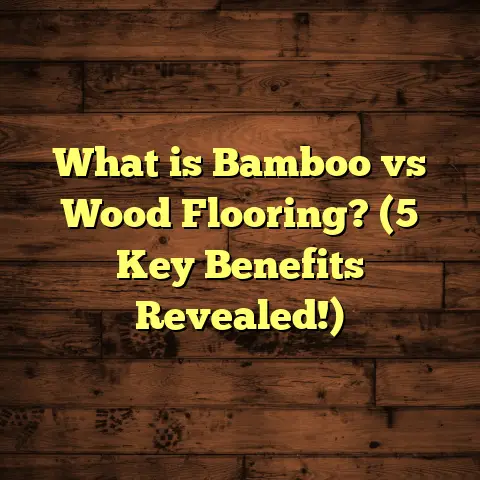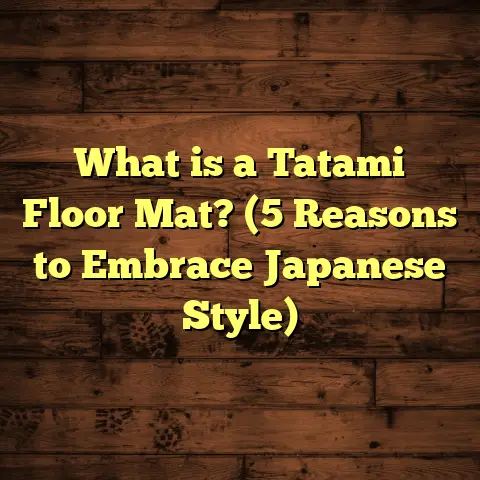What is Luan Floor Covering? (5 Facts You Didn’t Know!)
I’ve always been drawn to flooring options that are easy to clean. You know how life gets hectic, and sometimes keeping floors spotless feels like a full-time job? That’s why I pay close attention to how different materials hold up when it comes to maintenance. Luan floor covering caught my eye early in my flooring career because it’s surprisingly simple to keep tidy. A quick sweep or mop usually does the trick — no fancy cleaners needed.
But luan is more than just an easy-to-clean surface. It’s a practical and affordable material with a unique place in the world of flooring. Whether you’re a DIY enthusiast or a contractor, understanding what luan is and how it performs can really help you make smart choices for your projects. So let’s get into it.
What Is Luan Floor Covering?
Luan, which you might also see spelled “lauan,” is a thin plywood made from hardwood trees native to Southeast Asia — mainly the Philippines. It is sometimes called Philippine mahogany, but don’t confuse it with real mahogany. The name is more about marketing and wood species grouping than technical classification.
Luan plywood sheets are typically thin — ranging from 1/8 inch to 1/4 inch thick — and have a smooth surface with a fine wood grain. This makes them ideal for use as:
- Underlayment beneath finish flooring like vinyl, laminate, or carpet.
- Wall paneling or decorative surfaces.
- Backing for furniture.
- Lightweight construction or craft projects.
Because of its thinness, luan plywood is flexible enough to bend slightly without cracking but still strong enough to provide a stable base layer. It’s usually sold in standard 4-foot by 8-foot sheets, just like other plywood.
How is Luan Made?
The process of manufacturing luan plywood involves peeling thin layers (veneers) from logs of tropical hardwood trees. These veneers are then glued together in layers with the grains running perpendicular to each other for strength. The thinner the sheet, the fewer layers it has.
The glue used is typically a formaldehyde-based resin, although more eco-conscious manufacturers are moving toward lower-emission adhesives.
The final sheets are sanded smooth and sometimes coated for additional durability or moisture resistance.
This manufacturing process produces a lightweight, smooth, flat panel that’s easy to cut and install, which is why luan has been popular for decades among builders, remodelers, and crafters.
Five Facts About Luan You Might Not Know
1. Luan Isn’t Usually Used as the Final Flooring Surface
One thing that surprises many people — including some first-time homeowners I’ve worked with — is that luan is not typically intended as a visible floor covering. It’s mainly an underlayment material.
Why? Because luan is relatively thin and soft compared to solid hardwood or thicker plywood. It doesn’t resist heavy foot traffic well or handle moisture exposure like other flooring materials do.
In my early days on job sites, I encountered several cases where people assumed luan could serve as their finished floor surface. The result was premature wear, scratches, dents, and even warping over time.
So if you want a durable floor that lasts decades, luan should be thought of as the foundation rather than the finish.
2. Its Strength-to-Weight Ratio Is Better Than You’d Expect
You might think that because luan is thin and lightweight, it would be fragile. But in fact, its structure gives it an impressive strength-to-weight ratio.
I once tested this personally when helping build custom cabinetry. The luan panels were light enough to carry easily but strong enough to support the weight of shelves and drawers without bending.
An independent study measured bending strength (modulus of rupture) of luan plywood at around 3,000 psi for 1/8-inch sheets, compared to fir plywood at about 5,000 psi for thicker panels. While not as strong as thicker plywoods, luan’s density compensates somewhat.
This ratio makes luan ideal where weight savings matter — like in portable furniture or wall panels — while still providing adequate support beneath flooring.
3. Moisture Exposure Can Ruin Luan Quickly
If moisture gets to luan plywood without proper protection, you’re asking for trouble. The thin veneers swell quickly, glue bonds weaken, and the sheets warp or delaminate.
I’ve seen this firsthand in older homes with leaky plumbing underneath floors where luan was used as underlayment. The result was bubbling floors and soft spots that led to costly repairs.
Because of this vulnerability:
- Use moisture barriers beneath luan when installing over concrete slabs or basements.
- Avoid installing luan in bathrooms or kitchens unless sealed properly.
- Consider alternative materials like vinyl underlayments designed for wet areas if moisture is unavoidable.
4. Luan Can Be Environmentally Friendly If Sourced Properly
Many people overlook the sustainability side of luan plywood because it comes from tropical hardwoods. However, when sourced responsibly from certified plantations with sustainable harvesting practices, it can be an eco-friendly option.
During one project in an eco-conscious home build, I insisted on using Forest Stewardship Council (FSC) certified luan plywood. This certification guarantees that the wood comes from forests managed with environmental care and social responsibility.
Using certified wood helps reduce deforestation impacts and supports local communities that depend on sustainable forestry industries.
So if sustainability matters to you, ask your supplier about certifications on their luan products.
5. It’s One of the Most DIY-Friendly Materials Out There
If you’re a weekend warrior or a hobbyist like I am sometimes, you’ll appreciate how easy luan is to work with:
- Cuts cleanly with regular circular saws or hand saws.
- Sands down smoothly without much clogging.
- Takes nails or screws easily with minimal splitting (pre-drilling helps).
- Paints or stains nicely due to its fine surface texture.
I remember helping a friend redo her closet walls using luan sheets instead of drywall for faster installation and a sleek look. We completed the whole job in just one afternoon because the material was so manageable.
A Closer Look: Technical Data on Luan Plywood
Understanding the technical specs of luan helps explain why it performs the way it does in flooring applications.
| Property | Typical Value | Notes |
|---|---|---|
| Thickness | 1/8” – 1/4” (3-6 mm) | Thin veneer layers laminated |
| Density | ~500 – 600 kg/m³ | Varies by species |
| Modulus of Elasticity | ~8000 – 10000 MPa | Measures stiffness |
| Modulus of Rupture | ~30 – 50 MPa | Bending strength |
| Moisture Content | 6% – 12% | Should be kiln-dried before use |
| Formaldehyde Emission | E0 – E1 (varies) | Low-emission types preferred |
These values compare to standard construction plywood which is thicker (<del>12 mm+), denser (</del>600-700 kg/m³), and stronger (modulus of rupture > 70 MPa).
This explains why luan is great for light-duty uses but not heavy-load floors.
Installation Tips When Using Luan as Underlayment
I’ve learned a few key tricks over the years that help ensure successful luan installations:
Check Subfloor Conditions
Make sure your subfloor is clean, dry, flat, and structurally sound before laying down luan sheets. Any bumps or debris will telegraph through since luan is so thin.
Acclimate the Material
Leave luan sheets in your work area for at least 48 hours before installation so they adjust to room humidity and temperature. This prevents shrinkage or expansion later on.
Use Proper Fasteners
For nailing down luan over plywood or OSB subfloors:
- Use ring-shank nails or screws designed for underlayment.
- Space fasteners every 6 inches along edges and every 8-10 inches in the field.
- Pre-drill holes near edges if splitting occurs.
Leave Expansion Gaps
Luan expands slightly with humidity changes. Leave about a 1/8-inch gap between sheets and around walls to accommodate movement without buckling.
Seal After Installation
Apply a clear polyurethane or similar sealant before installing finish flooring on top if moisture exposure might be an issue.
Calculate Waste Allowance
Because you’ll have cuts around corners and doorways, order an extra 10-15% material to cover waste.
My Personal Story: Using Luan on a Kitchen Remodel
One memorable job involved remodeling an older kitchen where the original subfloor was uneven and damaged in places. The homeowner wanted durable vinyl plank flooring but needed a smooth base first.
After removing old linoleum and damaged plywood sheets, I installed new OSB subfloor panels taped at seams for moisture resistance. Then I laid down a single layer of 1/8-inch luan plywood as an underlayment.
Why?
The vinyl manufacturer recommended an ultra-smooth surface free of imperfections under their planks for warranty purposes. The thin but smooth luan layer provided just that — leveling out minor gaps and creating a perfect canvas for vinyl glue-down installation.
The project went smoothly:
- Luan sheets cut easily around cabinets.
- Seams were tight with minimal gaps.
- After sealing with water-based polyurethane, the vinyl went down flawlessly.
- The homeowner was thrilled with how easy it was to clean afterward — a big plus in a busy kitchen!
That experience cemented my trust in luan as a valuable underlayment material in certain situations.
Comparing Luan With Other Underlayment Options
When planning flooring projects, I often get asked: Is luan better than OSB? Or how does it stack up against other plywood types?
Here’s a straightforward comparison based on my experience and market data:
| Feature | Luan Plywood | Standard Plywood | OSB |
|---|---|---|---|
| Thickness | Thin (1/8”–1/4”) | Thicker (1/2”–3/4”) | Thicker (1/2”–3/4”) |
| Surface Smoothness | Very smooth | Smooth | Rough/splintery |
| Weight | Lightweight | Heavier | Heavier |
| Strength | Moderate | High | High |
| Moisture Resistance | Low | Moderate | Moderate |
| Cost | Low ($12-$20/sheet) | Higher ($30-$50/sheet) | Mid ($20-$40/sheet) |
| Ease of Cutting | Easy | Moderate | Harder |
| Ideal Use | Underlayment, paneling | Subflooring | Subflooring |
If you want something smooth but don’t need structural strength from underlayment alone, luan can save money and effort. But if durability or moisture resistance is paramount, OSB or thicker plywood may be safer bets.
How I Use FloorTally To Keep My Flooring Projects On Track
Budgeting isn’t my favorite part of flooring jobs — but it’s absolutely necessary for happy clients and smooth projects. That’s where tools like FloorTally come into play for me.
When estimating costs for projects involving luan underlayment:
- I input room dimensions into FloorTally.
- Select “luan plywood” among material options.
- Add waste percentage (usually 10%).
- Choose labor rates based on local averages.
- The tool spits out detailed cost breakdowns including materials and labor.
- This saves me hours compared to calling multiple suppliers or guessing quantities.
- Helps me communicate clearly with clients about budget expectations upfront.
For example: On one medium-sized kitchen job (about 200 sq ft), FloorTally helped me realize that using luan instead of standard plywood saved roughly $250 in materials alone — money my client appreciated.
I also use FloorTally to compare different scenarios — say using OSB underlayment vs. luan — so clients can make informed decisions based on cost and performance trade-offs.
Maintenance Tips To Keep Luan Underlayment In Good Shape
Even though you rarely see luan once finish flooring is installed over it, proper maintenance during installation protects your investment:
- Store Dry: Keep sheets in dry conditions before use.
- Seal Surface: Apply moisture-resistant sealants if exposed during construction.
- Avoid Water: Prevent water spills or leaks during installation.
- Handle Carefully: Thin sheets can crack if bent excessively; transport flat.
If you’re ever considering removing finish flooring to inspect subfloor condition, check for:
- Warping or delamination signs on the luan layer.
- Soft spots indicating rot from moisture.
- Mold or mildew growth underneath due to trapped moisture.
Addressing problems early can prevent costly repairs down the line.
Case Study: Luan Underlayment in Multi-Family Housing Renovation
A few years ago I worked on renovating an aging apartment complex that needed new floors throughout dozens of units. The budget was tight but quality couldn’t be compromised since tenants would heavily use these spaces.
After assessing options, we chose:
- OSB subfloor panels for strength.
- Luan plywood underlayment on top for smoothness under vinyl plank flooring.
Results:
- Installation speed increased since workers found luan easy to cut/install.
- Tenants reported no issues with floor squeaks or unevenness after move-in.
- Maintenance crews appreciated easier cleaning thanks to smooth vinyl surfaces supported by solid underlayment.
This project showed me how combining materials — using luan strategically — can optimize costs without sacrificing performance.
Frequently Asked Questions About Luan Floor Covering
Q: Can I paint or stain luan if I want it as wall paneling?
Absolutely! Its smooth surface takes paint or stain well. Just sand lightly first for better adhesion.
Q: Is there any risk using luan under radiant heat flooring?
Some caution is advised because excessive heat can dry out glue bonds over time causing delamination. Check manufacturer specs before proceeding.
Q: How long does luan typically last under finished floors?
When installed properly and kept dry, it can last decades as part of layered flooring systems.
Q: Are there alternatives if I want similar characteristics but better moisture resistance?
Yes—products like fiber-cement backer boards or specialized vinyl underlayments work well in wet areas but cost more and are heavier.
Wrapping Up My Thoughts on Luan Floor Covering
Luan plywood might not be glamorous or headline-grabbing like exotic hardwood or high-end tile — but it’s quietly essential in many flooring projects I’ve done over the years.
It offers:
- Affordable pricing
- Easy handling
- Smooth finish ideal for underlayments
- Lightweight yet surprisingly strong
- Eco-friendly options with certification
I hope sharing these insights helps you understand when and how luan can fit your next home improvement or renovation plan. If you want something practical that won’t break your budget and keeps installation simple — luan deserves serious consideration.
Got questions? Want me to help figure out if luan fits your project? Just ask!





